________________
Relations
psychology. Causality is perceived and the act of perception is one. The Jaina believes in the identity of the self which is inclusive of its changes. The self may perceive the cause first and the effect next. But it is the same self who perceives the two events. The self that perceives the subsequent event has not let the first perception go adrift. The perceptions are events in the history of the self and as such they occur as real changes in the self. The perception of the prior term spells a change and so also does the perception of the posterior term. But the change represented by the first perception is not lost hold of by the self when he perceives the subsequent event. So there is no difficulty that the self can perceive the two in succession and also as together. Of course, the Buddhist may assert that it is only a hypothesis of the Jaina. But the hypothesis explains a real fact. It is undeniable that we connect the two events-earlier and later--as cause and effect. The Buddhist does not deny that this act of connecting is a fact. What he denies is that the accredited instruments of knowledge, perception or inference, are competent to apprehend this relation. He concludes that the knowledge of causality is an ideal judgment having no bearing upon the objective reality. But the Jaina thinks this to be a hasty conclusion, which is not only unwarranted but has also been a source of far-reaching mischief. It condemns all thought and all philosophical speculations. The difficulty of the Buddhist as well as of idealists in general lies in the supposition of incompatibility of change with identity. But this is the fundamental datum of Jaina thought and we have taken considerable pains to elucidate the Jaina position in the preceding chapters.
What is the organ of the knowledge of causality? The Jaina answers that it is perception of the concomitance in agreement and difference. The Jaina position is found to be endorsed by J. S. Mill who recognizes the Joint Method as a distinct and different organ, severally from the Method of Agreement and the Method of Difference. The Jaina takes the observation of concomitance in agreement and in difference to be one observation. And as regards the universality and the necessity of causal relation, the Jaina posits another instrument which he calls tarka, which we may tentatively render as 'reasoning' which assumes the form of a reductio ad absurdum. It is by the aid of reasoning
Jain Education International
195
For Private & Personal Use Only
www.jainelibrary.org




